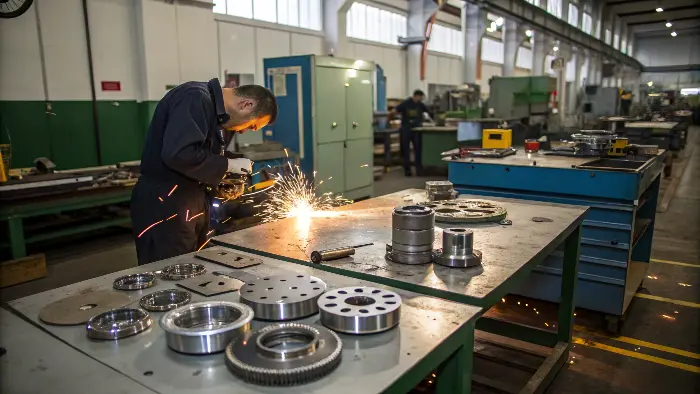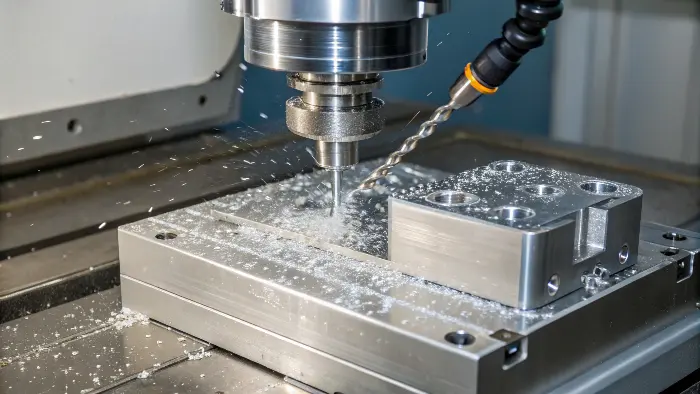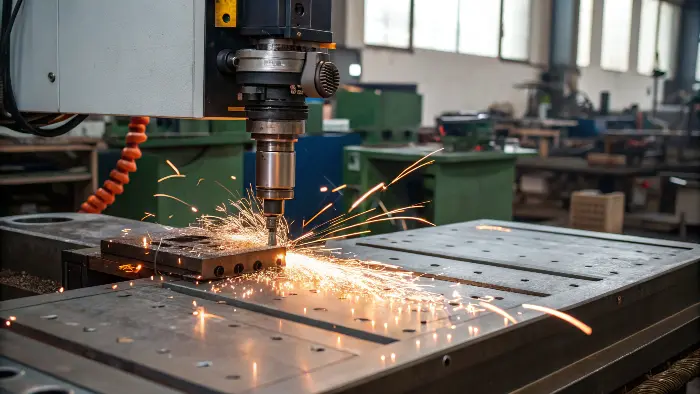Struggling with inconsistent machining results? Worn tools and poor finishes can halt progress. Optimizing parameters for each metal is the key to success.
Optimizing cutting speed, feed rate, and depth of cut for each specific metal is crucial. This ensures high-quality results, minimizes tool wear, and boosts your overall production efficiency when machining different metals.

Getting these parameters right isn’t just about a good finish; it’s about saving time, money, and headaches in your workshop. I’ve learned over the years that a generic approach simply doesn’t work when you’re dealing with the unique personalities of various metals. Let’s dive into how you can master the art of material-specific machining.
How Can You Best Machine Aluminum Alloys?
Aluminum seems easy, but wrong settings cause gummy chips and poor surfaces. Avoid these common frustrations by understanding its unique needs for smooth, efficient machining.
For aluminum, use high cutting speeds (250-1500 SFM depending on the alloy), medium feed rates, and sharp, polished tools. Water-soluble coolant is also essential to prevent material buildup and ensure a good finish.

When I first started my journey in a CNC shop, aluminum was one of the first metals I got really familiar with. It’s relatively soft and generally easy to machine, which makes it a good starting point. However, "easy" doesn’t mean you can be careless. Good chip formation and low tool wear are achievable if you respect its properties. For instance, with a common alloy like 6061-T6, I usually aim for cutting speeds between 250-500 surface feet per minute (SFM). If I’m working with cast aluminum alloys, I can often push that higher, into the 500-1000 SFM range. For tougher wrought alloys like 7075, the speeds can go even higher, sometimes 800-1500 SFM. Feed rates should be kept moderate. A good starting depth of cut for 6061 aluminum might be around 0.100-0.150 inches. The choice of tooling is also very important. I always recommend using sharp, highly polished tools. This helps prevent the aluminum from sticking to the tool, which is a common issue. High-quality carbide or high-speed steel (HSS) tools specifically designed for aluminum are your best bet. And don’t forget coolant! It’s vital for reducing heat, preventing thermal expansion of the part, and improving the surface finish. A water-soluble coolant, typically at a concentration of 5-10%, works very well. Finally, ensure your workpiece is held rigidly and your machine setup is stable to minimize any vibration. Regular machine and tool maintenance also plays a big part in consistent results.
| Parameter | Recommendation for Aluminum (e.g., 6061-T6) | Notes |
|---|---|---|
| Cutting Speed | 250-500 SFM (higher for other alloys) | Varies significantly with specific alloy |
| Feed Rate | Medium | Adjust based on tool diameter and operation |
| Depth of Cut | 0.100-0.150 inches (initial) | Depends on machine rigidity and power |
| Tooling | Sharp, polished carbide or HSS | Prevents material adhesion |
| Coolant | Water-soluble (5-10% concentration) | Essential for heat reduction and finish |
| Machine Setup | Rigid fixturing | Minimizes vibration |
What’s the Secret to Effectively Machining Steel?
Machining steel can be tough, leading to rapid tool wear and longer cycle times. Careful parameter control is essential to avoid these issues and achieve precision.
Effectively machining steel, especially hardened types, requires careful control of cutting speeds and feeds. Use robust tooling like carbide with strong edge geometry, and apply ample coolant to manage heat.

Steel is a whole different animal compared to aluminum. It demands more from your tools and your machine. I’ve spent countless hours figuring out the best approaches for various steel grades, from mild steels to tough tool steels. One of the biggest challenges is managing tool wear. If your parameters are off, you can burn through cutters very quickly. For hardened steels, the machining time naturally increases, and so does the cost, so getting it right is even more critical. Careful control over cutting speeds and feeds is absolutely paramount. You can’t just "hog out" material like you might with softer metals. When it comes to tooling, especially for hard milling (machining hardened steel), I opt for inserts with a strong cutting edge geometry, often ball-nose end mills for contouring. Carbide grades designed for steel are a must. For steels hardened above 50 HRC, ultra-fine or nano-crystalline grain carbide substrates perform much better. In some high-speed applications on very hard steels, Cubic Boron Nitride (CBN) tools are fantastic due to their extreme hardness and good thermal conductivity. Coolant is another critical factor. When machining hard steels, using plenty of cutting fluid or coolant is essential for dissipating the intense heat generated and prolonging your tool life. Some general tips I always follow: use a robust cutting edge, ensure your tool and toolholder are as rigid and stable as possible, and monitor tool wear regularly. For example, when I’ve had to machine D2 tool steel at around 62 Rc, I’ve found success using negative rake inserts, a radial engagement (stepover) of about 30% of the cutter diameter, and a relatively small axial depth of cut, perhaps in the tenths of a thousandth of an inch per pass for finishing.
| Parameter | Recommendation for Steel (General) | Notes for Hardened Steel (>50 HRC) |
|---|---|---|
| Cutting Speed | Lower than aluminum, varies by grade | Significantly lower, or use CBN for high speed |
| Feed Rate | Moderate, controlled | Lower, precise control needed |
| Tooling | Coated carbide, strong edge geometry | Ultra-fine grain carbide, CBN |
| Coolant | Ample flood coolant or high-pressure | Essential for heat dissipation |
| Cutting Edge | Robust design | Negative rake can be beneficial |
| Tool Stability | Maximize rigidity | Critical to prevent chatter/breakage |
| Tool Wear | Monitor frequently | Expect faster wear, adjust accordingly |
Why is Machining Titanium So Challenging and How Can You Overcome It?
Titanium’s strength and heat resistance make it a prized material, but also a nightmare to machine. It tends to stick to tools and generate extreme heat.
Machining titanium effectively requires optimized parameters like low cutting speeds and high feed rates, along with sharp, tough tooling and high-pressure coolant to combat its tendency to adhere to tools and resist heat.

Ah, titanium. This metal has certainly given me some challenges over the years, but the results are often worth the effort due to its incredible strength-to-weight ratio and corrosion resistance. It’s famous for being strong and very heat resistant, which are great properties for the final part, but not so great when you’re trying to cut it. One of its most notorious characteristics is its tendency to gall and weld itself to the cutting tool. This, combined with its low thermal conductivity (meaning heat stays concentrated in the cutting zone), makes tool life a major concern. To overcome these issues, you really need to dial in your parameters and select the right tooling. Generally, I use lower cutting speeds compared to steel, but often higher feed rates. This helps to maintain a thicker chip, which can carry away more heat. Sharp, positive rake cutting tools made from premium carbide grades are essential. Coatings can also help reduce friction and prevent adhesion. Because of the heat generation and the material’s reactivity, a generous and consistent application of coolant is absolutely critical. High-pressure coolant directed right at the cutting edge can be very effective in flushing chips away and cooling the tool and workpiece. Maintaining tool sharpness is key; once a tool starts to dull, problems escalate quickly with titanium. I always advise my clients and fellow engineers that when machining titanium, it’s not a material you can rush. Patience and attention to detail in your setup and parameter selection will pay off. You also need a very rigid machine and fixturing setup because any vibration will exacerbate tool wear and can lead to poor surface finish or even tool failure.
| Parameter | Recommendation for Titanium | Rationale |
|---|---|---|
| Cutting Speed | Low (e.g., 60-200 SFM for Ti-6Al-4V) | Reduces heat generation and tool wear |
| Feed Rate | High (relative to cutting speed) | Maintains chip thickness, helps carry heat away |
| Tooling | Sharp, positive rake, premium carbide | Minimizes cutting forces and adhesion |
| Tool Coating | PVD coatings (e.g., TiAlN, AlTiN) | Reduces friction, improves wear resistance |
| Coolant | High-pressure, high-volume flood coolant | Essential for cooling and chip evacuation |
| Depth of Cut | Moderate, avoid dwelling | Prevents work hardening and tool rubbing |
| Machine Rigidity | Very high | Minimizes vibration, crucial for tool life |
Conclusion
Optimizing machining parameters for each metal type is not just best practice; it’s essential for quality, efficiency, and cost-effectiveness in any CNC machining project.


